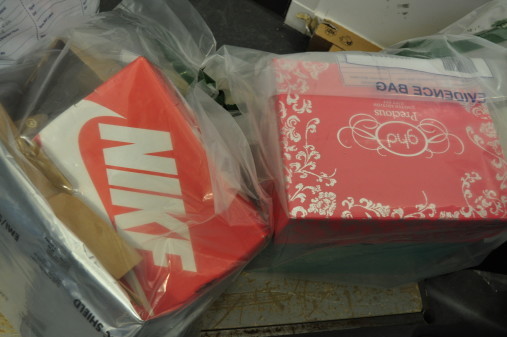Highland council trading standards officers have successfully used covert operations to catch an online seller of counterfeit goods, in their seventh sting of the year since April.
A local individual using online market places to sell counterfeit clothing, footwear, hair straighteners and wireless headphones has been reported to the procurator fiscal after a surveillance operation involving test purchases, tracking down the seller’s address and seizing the illegal goods under warrant, and with police support.
The trading standards officers have issued stark warnings both to sellers and consumers of counterfeit goods online.
To the sellers, ‘We have powers we can use. We’re on to you.’ To consumers, ‘Be aware. Counterfeit electrical goods pose serious hazards. And note that you are supporting serious organised crime.’
Tracking down online sellers of counterfeit and illegal goods is a burgeoning and increasingly complex part of trading standard’s work, said the council’s trading standards manager David Mackenzie.
“The so-called ‘collaborative economy’ like Gumtree, ebay, Uber, AirBnB and social media, has opened up many opportunities for people to sell things.
“People who would never dream of opening a shop can sell online. Most people want to do the right thing, and most online selling is good and positive, giving more choice.”
Mr Mackenzie said that people who get drawn in to selling counterfeit goods don’t take on board that they are part of serious organised crime networks operating much the same way as drug networks.
“Sellers, the modern equivalent of street traders, hire vans and head south to pick up the goods which could have come from who knows where.
“If they are electrical goods like hair straighteners, e.cigarettes or fancy headphones, they are likely to be manufactured abroad and be substandard and dangerous.
“The sellers advertise on a number of sites. Often we’ve noticed often they are women, perhaps because they are able to do this kind of activity from home and around children.
“It can be difficult for the public to spot ‘bad eggs’ and these practices are also not fair on legitimate traders.”
Mr Mackenzie said this type of crime was complex and time-consuming to track down, involving intensive detective work.
Covert surveillance is only used as a last resort, he added.
He said: “It’s important people know that we are active in this area, and that we engage with the selling group admins who agree to help us when they realise what is going on.”
Understanding trading standards in the Highlands
Trading standards has the power to conduct different types of surveillance under the Regulation of Investigatory Powers (Scotland) Act 2000.
It’s a complex, rigorous procedure not undertaken lightly, according to Highland council’s trading standards manager David Mackenzie.
Since April 2018, officers have applied for and been granted seven authorisations for different types of covert surveillance, compared with five authorisations in the whole of 2017.
Five investigations of this year’s investigations were into suspected sale of cigarettes and alcohol to underage children, one into the alleged sale of counterfeit goods and one investigation into the illegal supply goods and services.
They’ve had success in previous years in using covert surveillance to bring two repeat online offenders, one based in Kiltarlity, the other in Caithness, to justice. Both offenders received community pay back sentences.
One woman was advertising and selling jewellery on eBay which was described as being made of silver when the jewellery was in fact made of base metals.
The other using Facebook to sell counterfeit designer label clothing and perfumes, and electrical goods.
Mr Mackenzie said: “If something appears too good to be true then it normally is.
“If you are looking to buy something from the internet, you have to take into account where the items are coming from and how much you are paying for them.
“Fake goods cheat consumers, undermine legitimate local businesses and damage the interests of those who own the intellectual property rights.
“The public need to play their part by not supporting this illegal trade and those who chose to supply fakes can expect to be found out and firmly dealt with. If anyone has any information about sales of counterfeit goods, they can let us know anonymously at:
http://www.highland.gov.uk/counterfeits
.”
